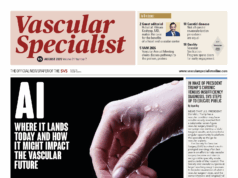
A “unique” case series of patients undergoing transcarotid artery revascularization (TCAR) in which the system was put to novel use for proximal intervention or incorporated in a hybrid approach to complex brachiocephalic disease demonstrated it to be effective in “providing safe, comprehensive treatment solutions,” the 2022 Vascular and Endovascular Surgery Society (VESS) winter annual meeting in Snowmass, Colorado (Jan. 27–29) heard.
Viraj Pandit, MBBS, delivered the findings on behalf of a University of Oklahoma, Tulsa, team of researchers led by vascular chief Peter R. Nelson, MD, informing delegates that a total of 94 patients underwent TCAR, with 8.5% (n=10) undergoing combined procedures. They found that two patients had concomitant common carotid artery stenosis, four patients had subclavian artery stenosis and one had an occluded contralateral internal carotid artery. None in the combined group had postoperative complications—stroke, myocardial infarction or cranial nerve injury—and all were discharged home on postoperative day one, Pandit added.
TCAR experience is expanding for the treatment of internal carotid artery stenosis, but its applicability in patients with more complex brachiocephalic disease has not been described, the research team reasoned as they set out to analyze the series. In that vein, they explored their experience with TCAR used in combination with other cerebrovascular interventions, including retrograde common carotid artery stenting and carotid-subclavian bypass. “This unique case series of patients undergoing TCAR in association with other cerebrovascular interventions demonstrated successful outcomes,” Pandit—formerly a vascular surgery fellow at OU Health and now a surgeon with VA in Fresno, California, and colleagues concluded.
Speaking to Vascular Specialist, senior author Nelson elaborated: “This paper probably falls between a traditional patient series and a technical note. Compared to traditional literature, this approach seems applicable to the new technology. It doesn’t require endarterectomy to accomplish the same combination of treatment. We can do it through the less invasive approach of a TCAR. The technical aspects are more or less how to maneuver the delivery system and how to engage the flow protection system that we’ve come to adopt with TCAR.”
Some of that older literature “suggests that doing tandem lesions had increased complication rates—and we’ve not seen that,” Nelson explained. “This is obviously a small number of patients, but we’ve seen no increase in complications and arguably similar or less complications in this small group,” he added.












